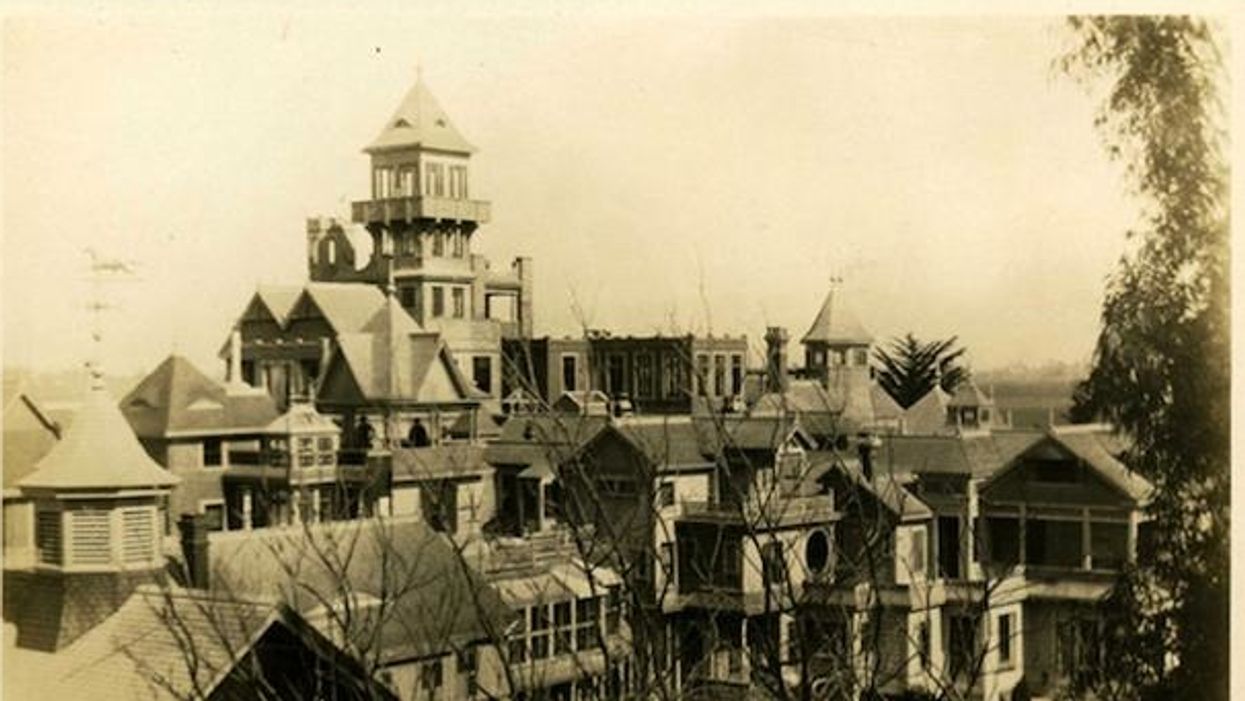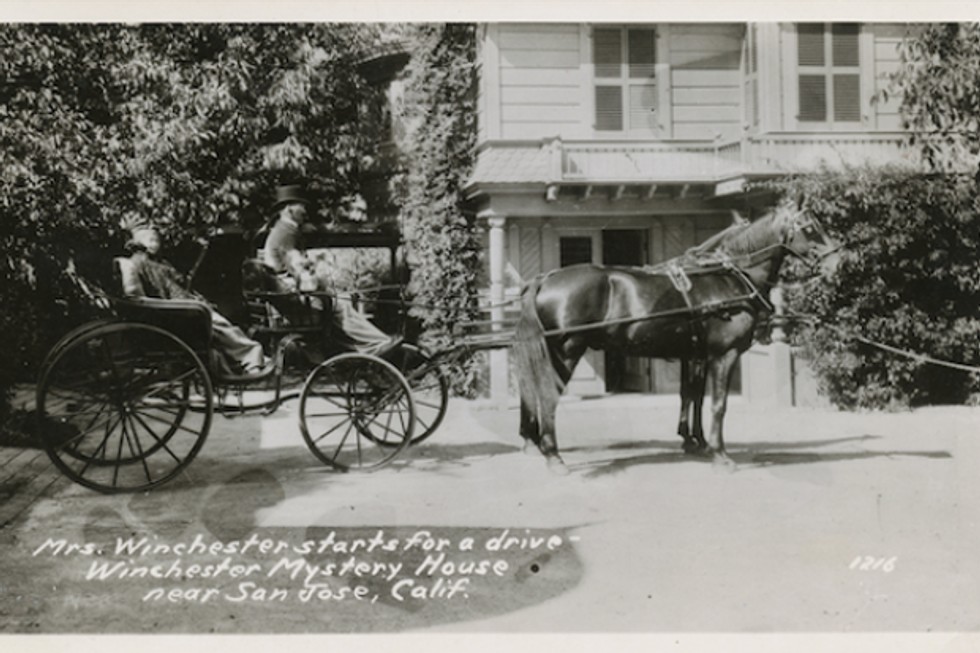Winchester Mystery House in San Jose is everyone's favorite haunted house, where candlelit tours and all the lore suggest that you might run into ghosts.
But here's the rub: According to a book by a local historian, the “mysteries" that attract thousands of people each year were manufactured by a family of 1920s-era carnies who first leased and then later purchased the property. In her tell–all book, Captive of the Labyrinth, Mary Jo Ignoffo lays out her research and findings, and today she shares the biggest deceptions surrounding one of California's top tourist attractions.
1. The house was under construction for 38 years.
Here's the history in a nutshell: Sarah Winchester, the wife of William Wirt Winchester and heiress to the Winchester Rifle fortune, moved to San Jose in 1886 and began building a house—a very large house whose rooms numbered 160 at the time of her death (although before the 1906 earthquake, it was much larger). Five months after she died the Brown family, long-time carnival workers who rented the house, held a public tour and kept on going, eventually buying the property and making it one of the state's top tourist attractions. They did not start the rumors—many began while Sarah was alive—but according to Ignoffo, they embellished the stories wildly and made up new ones in order to sell tickets. The legend as reported on the Winchester Mystery House website: A medium told Sarah that she was being haunted by spirits of people killed by the famous gun, and she would die unless she started building a house and never ceased. According to the website, construction lasted day and night for 38 years. "Not true," says Ignoffo. "Winchester's own letters explain that she sent workers away for months at a time." Requests for an interview with officials at the Winchester Mystery House have not been answered at this time.
2. Sarah Winchester was ashamed of the Winchester Rifle legacy.
This photo shows a small Winchester gun museum contained within the house. Tour guides say that Sarah felt consuming guilt over deaths caused by the firearms. Ignoffo suggests we are viewing those stories with 21st century eyes, and that, at that time in history, shame would have been far from Sarah's mind. "People associated with the company and those who wrote about it most often looked at it as an American success story," she says. "A sense of pride was more likely than one of guilt. It is highly unlikely that Sarah Winchester felt responsible or guilty for the manufacture of firearms—and she did not hesitate to invest and spend the money she earned from them."
3. Sarah Winchester constructed weird features in order to confuse spirits.
The website makes much of the architectural "oddities" of the house, such as doors and flights of stairs leading into walls, and how they were supposedly built to confuse vengeful ghosts. Ignoffo says there is a more natural explanation—the 1906 earthquake. She says that her research uncovered the fact that there was massive damage to the house in the trembler and that Sarah never fully repaired it. The stairs and doors that lead to "nowhere" are merely where damage has been sealed off or where landings have fallen away. "After the earthquake she moved to another house," Ignoffo explains. "She did not want to make the necessary repairs—it had nothing to do with spirits."
4. Sarah Winchester had seances in a secret room.
A highlight of a tour at the Winchester Mystery House is the seance room, where a guide will tell visitors that Sarah had regular sessions with the spirits. Ignoffo again says this is a case of modern eyes and tastes viewing yesterday's practices. At the time Sarah lived, the Spiritualism movement was a popular one, but Ignoffo says there is no evidence that Sarah particpated or held seances in her home. Even if she did, the historian says the idea of a special seance room for nightly sessions is far–fetched. "A seance was a social affair back then. To suggest, as tour guides do, that Sarah held solo seances in an interior closet of the house misrepresents the social nature of the ritual," she says. "If she wanted to hold a seance, she would have held it in the front parlor, as Spiritulists did." She adds that there are no mentions of a seance room in the house before a 1928 propaganda article, published well after Sarah died.
5. Sarah Winchester was obsessed with the number 13.
The website details the occurrences of 13 in the house: 13 robe hooks in the seance room, 13 panes of glass in several windows, a stairway with 13 steps, just to name a few. Ignoffo says these facts are used as evidence to prove the woman was ruled by superstition. "Refrences to the number 13 were added after Sarah's death, according to workers at the time," she says. "The 13 hooks were added about five years ago."
6. Sarah Winchester spied on her employees.
Under a section of the website titled "Mrs. Winchester the Spy" it is said that some employees believed Sarah could walk through walls and closed doors. The text claims Sarah had elaborate spying features built into the house. Ignoffo says: "There is no evidence she spied on her workers. Would a suspicious employer retain the same workers for decades? Would she name them in her will? Would she buy them homes? Would they name children after her? All these things happened."
7. The house looks today as it did then.
"The house that Sarah Winchester built stood seven stories at its highest," says Ignoffo. "The upper floors toppled in the earthquake of 1906. She did not replace the upper stories. Today's house looks much smaller than the original."
8. Sarah Winchester snubbed the President of the United States.
The story goes that Theodore Roosevelt attempted to visit Sarah at home in 1903, but was turned away. This is used as an example of her alleged weirdness. Ignoffo says that rumors likely started about Sarah because in life she was extremely private, refused to address gossip and did not engage much in the community. Ignoffo says this infamous presidential visit never occurred. "Eyewitness accounts state that the President's carriage never stopped at the Winchester place," she says. "Furthermore, Winchester had rented a house near San Francisco that year to prepare for the wedding of her niece. She was not at home."
9. The house is publicly owned.
"The Winchester Mystery House is listed on the National Registry of Historic Places, although the documentation is terribly flawed," says Ignoffo. "You are led to believe it is a National Landmark, and many people believe that that means it is publicly owned or a non-profit. The house is privately owned and is a for-profit enterprise." In fact, the historian says that the house is still owned by the decendants of the Brown family, and they reside in the Bay Area. On a recent tour, when asked who owns the house, a tour guide answered by saying, "I don't know. And when we are hired, we sign a document that makes us swear we will not discuss it or look it up."
10. After her death, no one stepped forward to tell the truth.
"Former neighbors and workers, along with two young men who were raised on the Winchester ranch, attempted to tell the press and the public about the interesting and good woman that Mrs. Winchester was," says Ignoffo. "Their stories fell on deaf ears, and successful Mystery House marketing over the years has made it extremely difficult to find a trace of truth about the real person."
---
This post was originaly published in 2013.






















